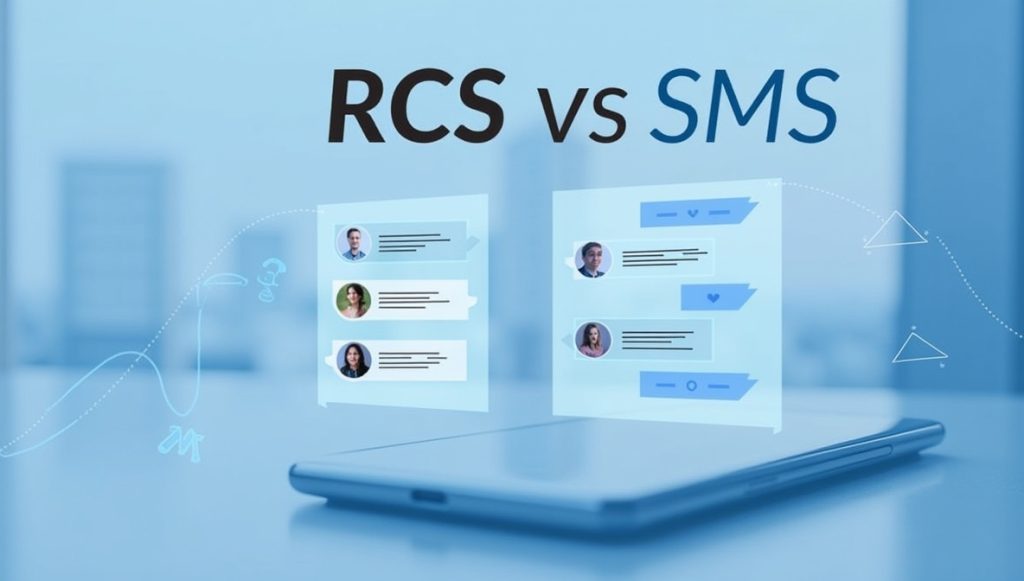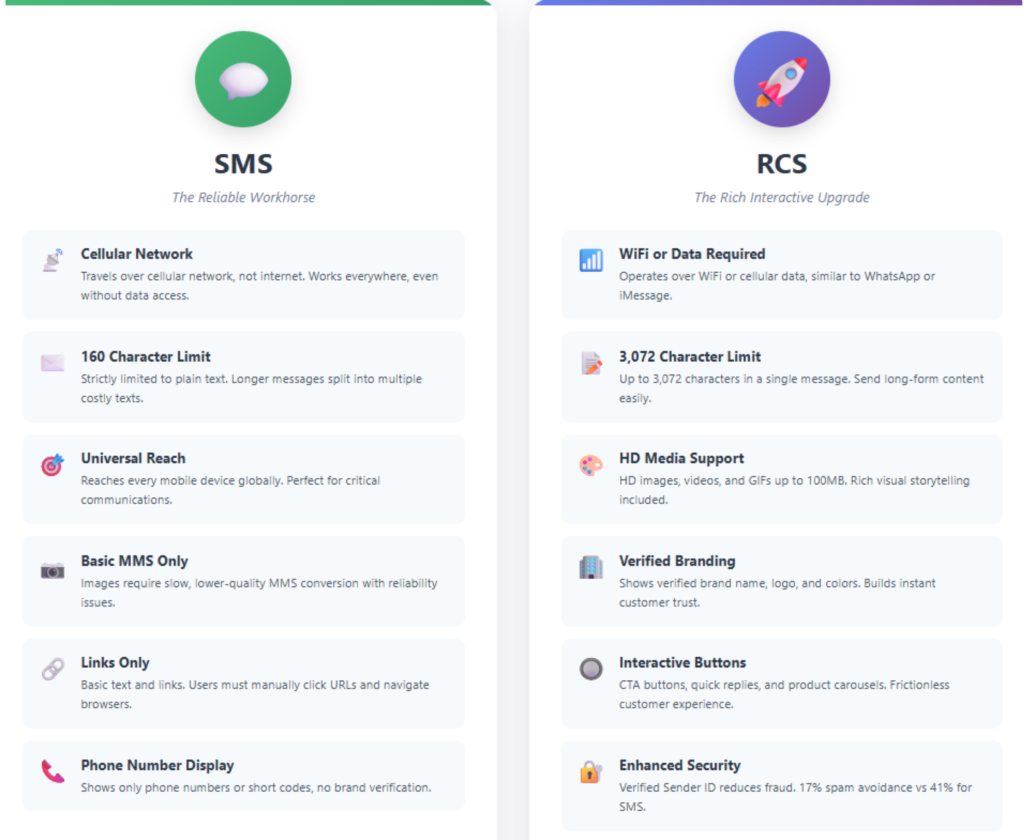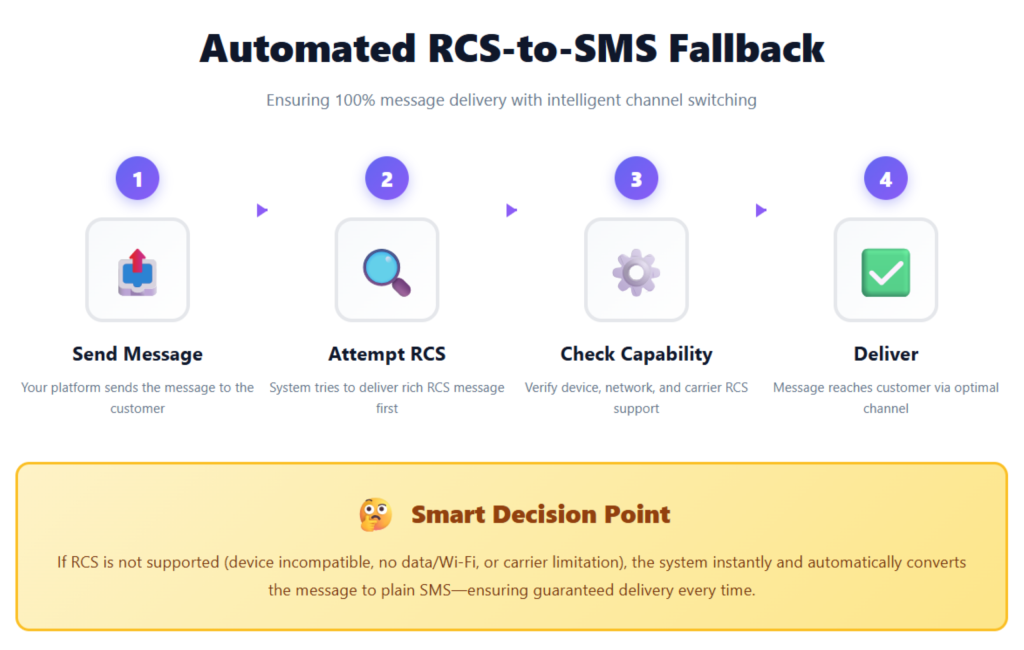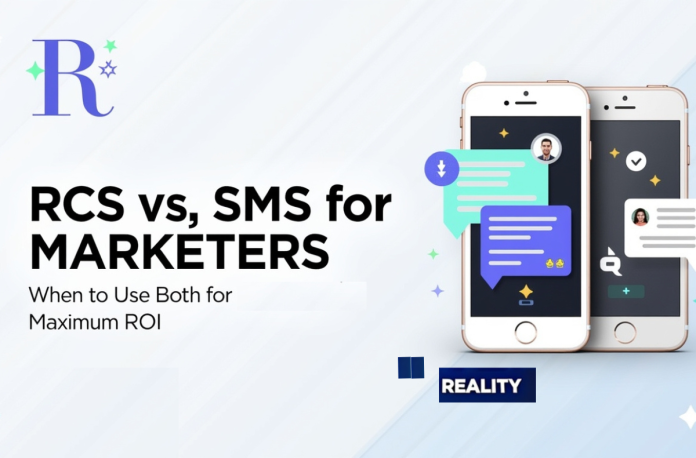Do you ever feel like your text message campaigns are stuck in the 1990s? Every marketer knows the frustration. When comparing RCS vs SMS, you want the unmatched open rates of texting, but you can’t show off your brand, include high-res images, or use interactive buttons. Traditional SMS is easy and dependable, yet its limitations feel old-fashioned, costing you precious revenue.
Today, we must deliver rich, app-like experiences right where our customer already is: their phone’s messaging app. This strategic change is the core of the RCS vs SMS choice. In fact, over one billion RCS messages are now sent daily in the U.S., proving this channel is quickly becoming mainstream. This guide will show the real difference in RCS vs SMS marketing power. You will learn exactly how to use the modern RCS message to drive high sales and when to trust simple text for guaranteed reach, increasing your overall ROI.
Key Takeaways
- RCS vs SMS demonstrates significant differences in functionality, focusing on interactivity and customer engagement.
- RCS offers rich media support, verified branding, and longer character limits than traditional SMS.
- RCS campaigns achieve much higher click-through rates and conversion rates, making them more cost-effective despite higher upfront costs.
- A hybrid messaging strategy ensures reliable delivery via SMS and enhanced engagement via RCS for optimal ROI.
- Understanding when to use SMS or RCS maximizes communication effectiveness and builds customer trust.
Table of Contents
What is the Core Difference between RCS vs SMS?
To maximize your messaging ROI, you must first understand the fundamental technology behind each protocol. This clarity helps you decide which channel is best for your specific goal.
SMS: The reliable ReliableWorkhorse
SMS, or Short Message Service, is the original text message. It remains the universal workhorse of mobile communication.
- How It Works: SMS messages travel over the cellular network itself, not the internet. That’s why they work on nearly every single phone, everywhere, regardless of whether you have data access.
- Limitations: It is strictly limited to 160 characters of plain text. For images, it forces a slow, low-quality conversion to MMS (Multimedia Messaging Service).
- Deliverability: SMS deliverability is unmatched. It reaches every mobile device. This makes it the non-negotiable anchor for critical communications.
RCS: The Rich Interactive Upgrade
RCS, or Rich Communication Services, is the natural, strategic evolution of SMS. Think of it as turning the basic text app into a powerful marketing tool.
- How it Works: RCS operates over Wi-Fi or cellular data, similar to apps like WhatsApp. It transforms the native phone inbox into a rich, engaging chat environment.
- Features: An RCS message supports up to 3,072 characters in a single message, plus HD images, videos, and GIFs up to 100MB. It is a massive functional upgrade over simple RCS vs SMS text.
- Branding: When you send an RCS message, it shows your verified brand name, logo, and contact information. This is crucial for building customer trust fast, something a simple SMS message can’t do.
The core difference between text message RCS vs SMS is interactivity. While SMS only supports basic links, RCS lets you add instant action buttons, product carousels, and quick replies, turning a simple notification into an actual conversation.

Technical Showdown of RCS vs SMS Messaging
The key distinction between SMS and RCS messaging lies in their underlying technologies. This DNA controls what content you can actually send and, more crucially, customers’ interactions. Knowing the tech behind SMS, MMS, and RCS is essential for successful campaigns.
Rich Media Limits and Character Counts
When comparing RCS to MMS or standard text, media support is the clearest distinguishing feature.
- SMS/MMS Limitations: A standard SMS is limited to 160 characters. Anything longer forces you to split it into several, more expensive texts. MMS can include low-quality pictures, but it tends to be slower and unreliable.
- RCS Advantage: The RCS message vs SMS debate is won right here. RCS supports up to 3,072 characters in a single message. You can send HD images, videos, and GIFs up to 100MB. This means rich media is part of the basic SMS vs. RCS text messaging capability.
Interactivity and Customer Engagement
This is where the money is made. Simple texting, RCS vs SMS, cannot compete on interaction.
- SMS: Allows only basic text and links. Users must manually click the URL, open a browser, and then navigate your site.
- RCS: Features-rich, interactive elements. You can embed suggested quick replies, dedicated Call-to-Action (CTA) buttons, and product carousels. This frictionless experience drastically boosts the efficiency of the RCS chat vs SMS environment.
Security, Trust, and Verified Sender IDs
Security is an essential topic when comparing RCS vs SMS security features. Customers are wary of generic, unverified texts.
- SMS Weakness: SMS messages are sent in plain text with no encryption. It’s vulnerable to spoofing, which is why 41% of users skip SMS due to potential spam worries, compared to just 17% avoiding RCS.
- RCS Strengths: RCS uses a required Verified Sender ID. When your message arrives, it shows your brand’s name and logo, not just a random number. This authentication reduces fraud risk and immediately builds trust.
RCS vs SMS Core Technical and Marketing Comparison
| Feature/Protocol | SMS | RCS | Primary Marketing Benefit |
|---|---|---|---|
| Character Limit | 160 (Plain Text) | Up to 3,072 | Cost efficiency, single RCS vs SMS message sends long content |
| Media Support | Text/basic MMS only | HD images, Video, Carousels | Visual merchandising and powerful brand storytelling |
| Branding | Phone number/Short Code | Verified Brand Name, Logo, Colors | Builds instant trust and reduces perceived spam risk |
| Interactivity | Links only | Buttons, Quick Replies, Carousels | Drives exponentially higher click-through rates (CTR) |
| Connectivity Need | Universal (Cellular Network) | Requires Wi-Fi or Cellular Data | SMS ensures delivery in low-data areas (Fallback necessity) |
How Does RCS Drive Maximum Marketing ROI?
The question isn’t whether RCS costs more than SMS; it’s whether the money spent delivers much higher ROI. The numbers are clear: RCS offers a dramatically lower cost per conversion. The proof of RCS vs SMS marketing power is right there in the figures.
Click-Through Rate and the Conversion Gap
Both SMS and RCS boast high open rates. SMS is traditionally at 98%, while RCS follows closely at 90-95%. They guarantee attention. But attention doesn’t equal conversion.
- SMS Performance: Traditional campaigns using simple text SMS vs RCS typically yield Click-Through Rates (CTRs) of 4% to 7%.
- RCS Triumph: With rich media and instant buttons, RCS campaigns drive CTRs of 15% to 30%, with peak results of 51%. That is up to seven times the engagement of simple RCS vs SMS.
Conversion Rates and Cost Efficiency
High engagement leads directly to higher sales.
- Conversion Gap: SMS typically only converts at 3% to 5%. RCS campaigns often achieve 20% to 40%, sometimes even hitting 80%.
- Cost Per Conversion: Though RCS messages cost 20% to 50% more than SMS, the huge jump in conversion makes it far more cost-effective per sale. For a high-value purchase, paying a little more for a message that converts at 30% beats paying less for one that converts at 5%. That shows the true ROI.

Strategic Use Cases for RCS vs SMS in Marketing
The secret to maximizing ROI is knowing exactly when to prioritize the universal reliability of SMS and when to prioritize the rich engagement of RCS. You should not choose between RCS and SMS; you should use them together.
SMS Priority For Reliability and Compliance
Use SMS when guaranteed delivery and simplicity are non-negotiable. Its universal reach makes it ideal for critical, time-sensitive communications.
- Critical Alerts: These are time-sensitive, urgent messages that must reach people instantly, even where data service is poor or nonexistent. Things like major weather alerts or bank fraud warnings.
- Authentication and OTPs: SMS remains the universal channel for Two-Factor Authentication (2FA) and One-Time Passwords (OTPs). This uses its reliable delivery and legal traceability.
- High-Volume Notifications: Basic order confirmations or simple shipping updates where speed and briefness matter more than rich content.
RCS Priority For Engagement and Conversion
RCS should be the priority for any customer interaction focused on building brand value, driving sales, using automation, or needing visual content.
- Abandoned Cart Recovery: This is a prime conversion use case. Use product carousels and immediate “Go to checkout” buttons. RCS conversion rates for abandoned carts are significantly higher, boosting sales by up to 20%.
- Promotional Offers: Use RCS’s verified branding (logo, name, colors) and high-resolution media to create an “app-like” experience directly in the native inbox. This rich, interactive format drives CTRs that are exponentially higher than those of an equivalent SMS vs. RCS promotion.
- Customer Service: Use the conversational session model for automated, AI-driven support. RCS can handle routine inquiries and booking adjustments quickly using quick replies, which is far more efficient than basic RCS message exchanges.
How Does Automated Fallback Ensure 100% Delivery?
The biggest challenge in the RCS vs SMS Android environment, or anywhere else, has always been adoption. Can you reach every customer with RCS? This is why a hybrid strategy is essential.
The iOS 18 Unification Factor
For years, the RCS vs SMS iPhone dynamic has limited rich messaging in the US. iPhone users communicating with Android users defaulted to low-quality SMS/MMS. However, Apple’s integration of RCS into iOS 18 (scheduled for late 2024/early 2025) changes everything. RCS now serves as the default protocol between iPhone and Android, unifying the mobile messaging landscape and greatly accelerating the business case for RCS Business Messaging.
The Automated RCS-to-SMS Fallback
For businesses, the solution is automated fallback. When you send a message:
- Your messaging platform attempts to deliver the rich RCS message first.
- If the customer’s device, network, or carrier does not support RCS (or they lack data/Wi-Fi), the system instantly and automatically converts the message to a plain SMS.
This mechanism is vital for RCS vs SMS ROI. It guarantees you always aim for high-conversion RCS messages while maintaining the reliable delivery of old-school text messaging. Checking compatibility and automatically switching channels is key to optimizing costs and maintaining customer trust.

Getting Started with Text RCS vs SMS Transition
Moving your strategy from simple text message SMS vs RCS to a hybrid model needs careful planning. You require a central platform that can manage the difficulty of carrier registration, template approval, and real-time channel switching.
Key Implementation Hurdles
While the benefits are clear, RCS requires more technical setup than traditional SMS.
- Carrier Registration: You must register with mobile carriers that support RCS Business Messaging.
- Verification: You need to complete a rigorous Verified Sender Profile process. This is what guarantees your logo and name appear.
- Template Pre-Approval: Interactive templates, such as carousels and buttons, often require carrier approval before you can send them out.
The Analytical Reporting Advantage
One major benefit of RCS for strategic marketers is its high-quality feedback loop. Unlike SMS, which offers limited reporting, RCS provides actionable analytics.
- Granular Data: You gain visibility into read receipts, typing indicators, and explicit click data on every button. This is a stark contrast to the few insights SMS gives you.
- Optimization: This rich data lets you accurately A/B test visuals, text, and button placement. Using this data is how you consistently perfect your strategy for maximum ROI.
Conclusion
The evolution from plain text RCS to SMS is complete. SMS is not dead; it is the essential delivery guarantee. RCS is the future of engagement and conversion. By adopting a hybrid messaging architecture with automated fallback, you future-proof your communications.
Stop choosing between dependability and richer features. Start using SMS for mission-critical alerts, and use RCS for all high-value promotional and conversational exchanges. Master the strategic use of both, and you’ll see unmatched engagement and better business results. The key to high ROI is not picking one, but knowing precisely when to deploy each.
FAQs
RCS messages are generally 20–50% more expensive than standard SMS. However, it is more cost-effective per conversion because it generates engagement rates that are three to six times higher, leading to superior ROI.
If you use Google Messages on Android, you can usually activate the RCS features. Go to the app, tap your profile picture or initials, then select Messages settings, tap RCS chats, and turn it on. This enables the rich messaging features.
Yes, Apple is integrating RCS support into its Messages app with iOS 18. This allows iPhone users to exchange higher-quality media and use improved group chat features when texting Android users, removing the old RCS vs SMS iPhone limitation.
SMS offers simple, 160-character messages. MMS handles images or video, but is slow and inconsistent. RCS is the newest approach, providing high-quality media, interactive options, carousels, and verified identity, all via Wi-Fi. That is the fundamental difference in RCS vs SMS vs MMS.
You use both to guarantee 100% message delivery and maximum conversion. SMS is your reliable tool ensuring critical alerts are always received (it reaches everyone), while RCS creates higher-value sales through superior engagement. Using a combined approach guarantees you won’t lose a message or a sale.











